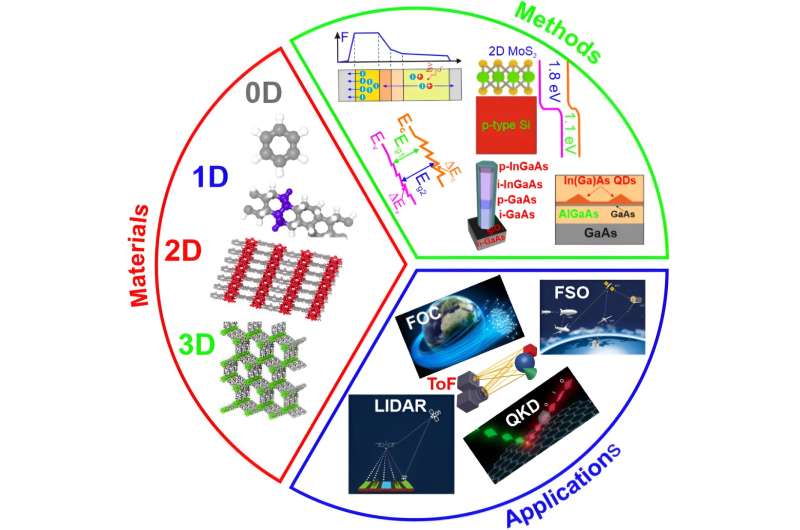This article has been reviewed according to Science X's editorial process and policies. Editors have highlighted the following attributes while ensuring the content's credibility:
fact-checked
peer-reviewed publication
trusted source
proofread
Infrared avalanche photodiodes from bulk to 2D materials

The avalanche multiplication effect can be used to detect low-power optical signals and even single photons due to the amplification mechanism within all main ranges: near- (NIR), short- (SWIR), mid- (MWIR) and long wavelength infrared radiation (LWIR). An advanced laser radar and weapons systems implemented in long-range army and space applications must detect, recognize and track various targets under a diversity of atmospheric conditions including absorption by CO, CO2 and H2O vapor, which leads to significant signal attenuation in the optical system.
That output signal suppression requires an extra amplifier along with a system to correctly detect the signal at the detector stage. The devices based on avalanche photodiodes (APDs) exhibiting high bandwidth (BW) and gain (M) to high gain-bandwidth product (GBW) and low excess noise [F(M)] at the same time are well matched for the detection of suppressed optical signals, e.g., in the long-range applications such as free-space optical communications (FSO), night vision, light detection and ranging (LIDAR/LADAR), time of flight (ToF), intelligent robotics and finally in battlefield conditions (military applications).
A main reason for this tendency is unquestionably the move to optical quantum information applications such as quantum key distribution (QKD). Those applications put severe requirements on detector performance that diverge from the performance of the well-established typical APDs. Therefore, improvement in GBW and F(M) reduction has been a key goal for APD's progress.
The methods to suppress the F(M) may be divided into three tactics. The initial approach could be to choose a material (to include "third wave" materials and their technologies) with advantageous multiplication properties. Next, the F(M) may be substantially limited by scaling the avalanche layer to use the non-local effect of the multiplication effect. The final method may be widely categorized as impact ionization engineering (I2E) exploiting properly designed heterojunctions.
The member of the "third wave" group—two-dimensional (2D) layered materials and their van der Waals (vdW) heterostructures could be also used in the field of avalanche multiplication to include single-photon counting technologies. The last decade has seen a spectacular growth in the research number of papers related to the promising 2D photodetectors, however, those materials exhibit low absorption caused by thin atomistic nature. Impact ionization leading to the carrier multiplication is a promising approach to fabricate 2D photodetectors with high detection efficiency.
In comparison to standard bulk, the 2D materials exhibit numerous exceptional capabilities, such as mechanical flexibility, strong light-matter coupling, self-passivated surfaces and gate-tunable Fermi level providing flexibility in heterostructure design. Those materials are characterized by different impact ionization coefficients versus carrier transport direction. In addition, not only conventional impact ionization effect but also ballistic avalanche mechanism was observed in 2D materials family.
Consequently, the research of innovative materials characterized by the low critical electric field for avalanche multiplication is significant in reaching energy-effective electric/photoelectric devices. The avalanche multiplication mechanism in conventional materials has been limited due to a high driving voltage what could be circumvented by 2D materials based APDs.
In a new paper published in Light: Science & Applications, a team of scientists, led by Professor Piotr Martyniuk from Institute of Applied Physics, Military University of Technology, Poland and co-authors from State Key Laboratory of Infrared Physics, Shanghai Institute of Technical Physics, Chinese Academy of Sciences, China have showed current status and future development on IR based APDs. The paper encompasses both bulk HgCdTe and AIIIBV based material systems including well known "third wave" material family member—superlattices.
In addition, the current progress in the new materials and architectures for high performance IR APDs was presented to include innovative "third wave" 2D materials, and the strategies to reach high performance APDs are presented.
More information: Piotr Martyniuk et al, Infrared avalanche photodiodes from bulk to 2D materials, Light: Science & Applications (2023). DOI: 10.1038/s41377-023-01259-3
Journal information: Light: Science & Applications
Provided by Chinese Academy of Sciences


















